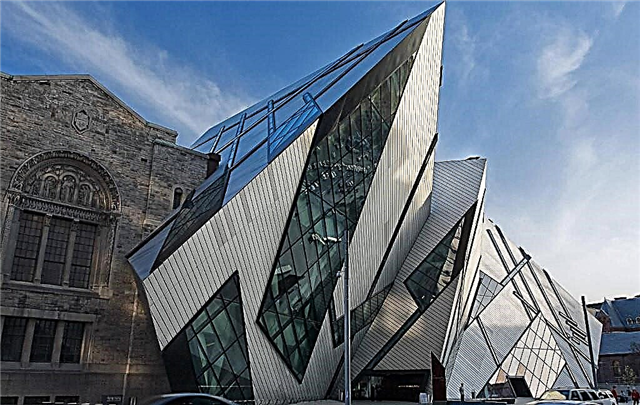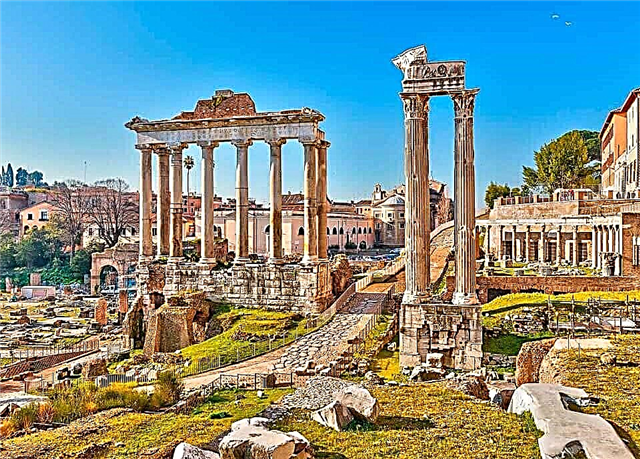Address: Moscow, st. Trade union, 123
Date of foundation 1937 year
Coordinates: 55 ° 37'25.9 "N 37 ° 30'51.0" E
Content:
One of the largest natural science museums in the world is located in the south-west of Moscow. Traveling along it makes it easy to travel back to the distant past. By examining the fossils and skeletons of extinct animals, children can learn about the origin of life and understand how the evolution of plants and animals on our planet took place.

View of the building of the Paleontological Museum
Museum history
The official history of the museum began in 1937. However, long before that, even during the reign of Peter I, teeth and bones of animals that lived in the Ice Age were brought to the Kunstkamera created in St. Petersburg. At the end of the 18th century, the paleontological collection of the Kunstkamera began to be stored in the Mineral Cabinet, which belonged to the Academy of Sciences.
In the mid-1920s, she moved to two halls of the Geological Museum. On an area of 1.5 thousand square meters. m placed old exhibits from the Kunstkamera and finds made by scientists at the beginning of the last century. In 1931, the collections were moved to the Moscow Neskuchny Garden, and 6 years later a separate museum of paleontology was created in the capital.
In the first years of the Great Patriotic War, the museum did not work, and its most valuable exhibits were transported to Kazakhstan. In 1944, the collection rooms were reopened to the public. Then several research expeditions were organized, and the museum was replenished with valuable finds. Their number grew rapidly, so it became necessary to construct a separate building. The design and construction of the new museum took a long time. It opened its doors to visitors in 1987.

Museum courtyard
Today the museum belongs to the Paleontological Institute and bears the name of the former director - the famous paleontologist and zoologist Yuri Alexandrovich Orlov. Rich collections are kept in a spacious building, built in the style of a medieval fort. The central building is surrounded by four towers, each of which houses a separate exhibition. The total area of museum halls and exhibitions exceeds 14.7 thousand square meters. m.
What can be seen in the museum
The museum building is very nicely decorated. Its decor includes ceramic panels, wood carvings, sculptures and wall paintings by animal painters. The exhibitions presented here are divided into four sections and are located in six halls. The total number of exhibits exceeds 5000 items.
At the beginning, the visitors are received by the introductory hall. This is a place where children learn what paleontology does, get acquainted with the history of this science and its main sections. The introductory hall allows you to answer the questions - what is the place of paleontology among other fields of knowledge and what is the practical significance of paleontological excavations.

Hall 4 - Late Paleozoic
There is something to be surprised at in the introductory hall! Kids love the picturesque ceramic panels "The Birth of the Sea", "The Tree of Life" and "Sea Lilies". The attention of children is invariably attracted by the huge skeleton of a mammoth, found in the middle of the 19th century in Siberia. Next to it are the skeletons of extinct primitive tetrapods, which scientists call parareptiles.
From the introductory part, the guests of the museum enter the Precambrian and Early Paleozoic halls. He talks about the initial stage of the development of the Earth's biosphere. Vendobionts, soft-bodied multicellular creatures, were the first to inhabit our planet. The museum hall displays prints of these primitive organisms, as well as traces left by the most ancient plants. Many visitors linger at a beautiful display case with golden amber pieces.
The next room is dedicated to the geological history of the Moscow region. Children may be interested to know that in ancient times, instead of the usual groves and fields, the Moscow region was covered with dense coal forests. There was also a period when the territory of the region was hidden under a thick layer of water. In this hall, tourists can see a giant extinct mollusk, a musk ox skull and a mammoth tooth.

Severo-Dvinsk gallery of professor Amalitsky
The fourth hall was created so that guests of the museum could learn about the oldest vertebrates that lived in the late Paleozoic and early Mesozoic eras. A stone slab with fossil fish, skulls of an ancient amphibian and an archosaurus, as well as skeletons and skulls of extinct reptiles - estemmenosuchs discovered in the Perm region are exhibited here.
The Mesozoic Hall is very inspiring for preschoolers. There they can examine in all details the dinosaurs known from cartoons. Any child is interested in standing next to the huge skeleton of a giant sauroloth, whose muzzle is very similar to a duck's beak. Young visitors to the museum are also attracted by the large skeletons of Diplodocus, Prestosuchus and Tarbosaurus.
The last exposition is dedicated to the Cenozoic and mammals. The skeletons of the ancestors of an elephant, a horse and a hyena are on display here. In the showcases of the hall, you can get acquainted with how the main orders of mammals developed.
Museum for children
Lectures, interactive classes and master classes at the Museum of Paleontology are some of the most interesting educational programs that Moscow offers to children. Museum staff conduct unusual lessons in which they acquaint students of the capital's schools with the environmental problems of the modern world.

Hall 6 - Cenozoic, mammals. Skull of the Trogonteria Elephant
A circle of young paleontologists has been working in the museum since the post-war years. Children take part in theoretical and practical classes, excursions and go to excavations. It is curious that some of the circle's graduates, having received specialized education, have become world famous specialists and have made a great contribution to the development of paleontological science.
For several years, at the end of May, the museum has been celebrating a special celebration - Museum Day. The annual holiday is dedicated to the birthday of Yu. A. Orlov. During it, the museum organizes free lectures, excursions and master classes. In addition, leading Russian paleontologists perform at the museum, and guests are invited to look at new exhibitions.
Excursions and games
You can travel through the halls of the museum on your own, but it is much more interesting to look at the exhibits when an experienced guide talks about them. Every day, the museum staff organizes thematic tours for children of all ages.

Hall 1 - introductory. The skeleton of mammoth Trofimov
Elementary students can learn about paleontological excavations and get to know the extinct giants. Children who study in grades 5-8 are told in detail about different types of dinosaurs and explain how modern animals appeared. High school students are introduced to the ways of development of reptiles, primates and humans, as well as plants and animals that inhabited the planet in the Jurassic period.
Quests are very popular these days, and the museum staff have prepared unusual paleoquests for individual visitors and families with children. Kids from 5 years old can take part in the game "Paleoscience", and children over 10 years old - in the quests "Age of Dinosaurs" and "Birds and Flight". Thanks to interesting excursions and games, the Paleontological Museum has become one of the most famous museums in Moscow.
In order to participate in the quest, you need to print game tasks from the Internet in advance or take ready-made booklets at the museum's ticket office. In the museum halls, visitors independently find the answers to the questions of the game. They look for traces of different types of dinosaurs and modern animals, fill out crosswords with Latin names of animals and learn to understand the differences between birds and flying reptiles.

Hall 5 - Mesozoic, dinosaurs and their contemporaries. Tarbosaurus skeleton
Useful information for visitors
The museum is open to visitors from Wednesday to Sunday from 10:00 to 18:00. The ticket office stops selling tickets 45 minutes before closing.Children under 6 years old are admitted to the museum free of charge. Free amateur photo and video filming is allowed in all halls.
Those interested can download a free application to their mobile device and travel around the museum with their own audio guide. In order to listen to the voice guidance, it is enough to read the QR code indicated on the exhibit or showcase or dial the number from the label. The audio guide is a great helper on a family tour of the world of paleontology! With him, you can walk through the halls at a comfortable pace and make stops wherever you want. Please note that the museum audio guide is constantly updated.

Hall 5 - Mesozoic, dinosaurs and their contemporaries. Diplodocus skeleton
How to get there
The museum is located at 123 Profsoyuznaya Street, 0.5 km from the Teply Stan metro station. In addition, it is easy to walk to the museum building in 10 minutes from the Konkovo metro station.










